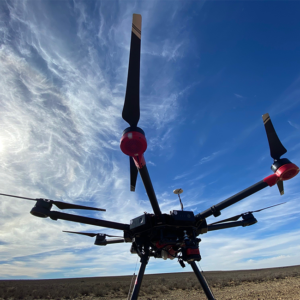Using Technology Supports Wildlife Conservation, Says The Endangered Wildlife Trust

The use of technology contributes significantly to wildlife conservation, enabling researchers to access areas previously considered dangerous and impassable.
It also aids in the rediscovery of species believed to be extinct and builds on the knowledge we already have on, not only the behaviour of species, but also the impact of human development and interference on wildlife.
“Drones are helping us roam large areas and access otherwise inaccessible sites. Advanced tracking systems, real-time data analytics, and artificial intelligence-driven solutions are empowering conservationists across the globe providing unprecedented tools to help identify, monitor, track and ultimately preserve wildlife,” says the Secretary-General of the Convention on the International Trade in Endangered Species of Wild Fauna and Flora (CITES), Ivonne Higuero.
She, however, warns that as we leverage growing technological capacities, we must also revitalise our commitments to sustainable development. This includes preventing destructive ecological impacts, mitigating threats to species and livelihoods arising from the misuse of technology, and ensuring digital inclusion for all by 2030.
The use of drones, for instance, is no longer a novelty, nor is the use of GPS tracking systems to monitor wildlife. What is considered new is the use of environmental DNA in the detection of elusive species, and the mapping of species distributions, and the real-time programming algorithms linked to tracking data that enable rapid response to wildlife threats.
Drones
Coupled with advances in artificial intelligence (AI), drones now have some sort of role to play in most industries. Their uses and benefits are only limited by our imagination and operational battery capacity. They deliver much-needed medicine to remote communities, scan compromised infrastructure for survivors during emergency disaster responses, or facilitate smart agriculture. Of course, there are more sinister potential uses for drones, blurring the lines between science and science fiction.
But, using drones for conservation has already shaped the future of the sector. Drones have been used in a variety of scientific studies, from detecting rare animals and counting colony-nesting birds to mapping habitats and creating 3D scans of trees.
The main practical advantage of a drone is not only necessarily its ability to go places that humans and their traditional modes of transport cannot get to; the biggest benefit is the fact they can perform the same tasks safely, eliminating the need to get people into dangerous situations.
But how do wild animals respond to these flying intruders? Is it ethical to use a drone to get close to an animal when it will result in a stress response? Perhaps the better question is whether the use of a drone is less or more detrimental to the animal than it is to approach it using traditional methods. This is an intriguing question, and one that should be considered prior to undertaking any new conservation project. At the Endangered Wildlife Trust (EWT) these concerns are very seriously considered on a case-by-case basis, through a formal ethics committee, prior to any deployment of drones for conservation.
As a legal drone operator in South Africa, the Endangered Wildlife Trust (EWT) carries out surveys for birds, bird nests and mammals, does topographical and vegetation surveys, provides aerial support to conservation teams during operations, assists the authorities in locating injured animals, carcasses, poisoning and poaching incidents, and inspects and photographs electrical infrastructure for maintenance and survey purposes. The non-profit is also using drones to attach anti-collision devices to linear electrical infrastructure and to assist specialists with surveys relating to Environmental Impact Assessments and related audits.

GPS Tracking
Drones may be the latest innovation in wildlife monitoring, but before their advent, GPS tracking technology had already established itself as a valuable tool for studying the movement, behaviour, and habitats of wild animals, particularly birds, over many years.
Birds of prey face unique conservation challenges, primarily due to their ability to traverse vast distances unhindered by physical barriers. This lack of confinement poses significant obstacles to traditional conservation methods. For instance, species like the White-backed Vulture and Cape Vultures routinely cover extensive distances, ranging from 80km to over 500km per day while foraging.
As a result, effective bird conservation heavily relies on technological advancements to comprehend species threats and implement appropriate conservation strategies. Vultures, for example, confront various hazards such as wildlife poisoning, power line collisions, and disturbance to nesting sites, all of which impact population numbers and breeding success.
The Endangered Wildlife Trust’s (EWT) Birds of Prey Programme has long utilised GPS tracking technology to establish a robust conservation framework for these species. These lightweight, solar-powered tracking units transmit precise location and movement data via cellular or satellite networks, offering unprecedented insights into the spatial biology of a diverse array of species. These data serve as a foundation for strategic conservation planning across expansive geographic regions.
Moreover, GPS technology enables researchers to concentrate efforts on critical areas for species survival. The EWT’s initiative to establish raptor safe zones, for instance, strategically targets properties frequented by birds for foraging and nesting, guided by behavioural data to mitigate human-induced threats effectively.
Fortunately, avian tracking technology continues to advance rapidly. Future developments hold promise for increased affordability, potentially revolutionizing data collection and enhancing the effectiveness of current conservation practices.”
eDNA
Most recently, the EWT has led the pack in the development and use of environmental DNA (eDNA) in terrestrial systems, which led to the rediscovery of the elusive De Winton’s golden mole – a species previously thought extinct.
With the help of this technology, the EWT team was able to detect and effectively rediscover the Critically Endangered De Winton’s golden mole (Cryptochloris wintoni) on the west coast of South Africa. This species had been lost to science for over 80 years.
Because detection and distribution mapping of elusive species is one of the major challenges of biodiversity surveys, the EWT’s Drylands Conservation Programme (DCP) has been working on eDNA sampling techniques to detect the presence of elusive and/or threatened terrestrial vertebrates.
Environmental DNA (eDNA) is genetic material that is shed by organisms into their environment, typically in the form of skin cells, hair or excretions, and may be sampled from environmental sources such as water, soil, or sediments. Isolation of this DNA from the environment can facilitate detection of organisms in the absence of obvious signs of their presence, and provide genetic information that can be used to identify, study and/or monitor species across time and space without having to catch, handle, or in some cases, even observe them.
The Drylands Conservation Programme used this technology to survey a range of elusive golden mole species across South Africa’s west coast, collecting soil from the linings of their subterranean burrows, and using genetic barcode markers to identify species. Through mapping species distributions, it facilitates conservation management of threatened species.
The EWT’s scientists are now also applying the eDNA approach in the detection of Endangered Riverine Rabbits, and threatened tortoises in the arid Karoo region of South Africa. For Riverine Rabbits, eDNA is collected from pellets (droppings) gathered in the field, rather than soil.
The application of eDNA has the potential to revolutionize conservation science and practice. Although there are many challenges associated with using this approach in broad biodiversity surveys or monitoring projects, with careful consideration of the challenges and potential limitations, the application of this technique can open many doors to answering research questions and finding new solutions to conservation challenges, including assessing potential impacts as a result of proposed developments in sensitive areas.
Through the use of technology, scientists are able to ensure that species being researched and surveyed are largely undisturbed. It could also contribute to a greater base of information about species in remote areas informing conservation planning and practice.
** World Wildlife Day is celebrated annually on 3 March. The theme for 2024 was People and Planet: Exploring Digital Innovation in Wildlife Conservation.
